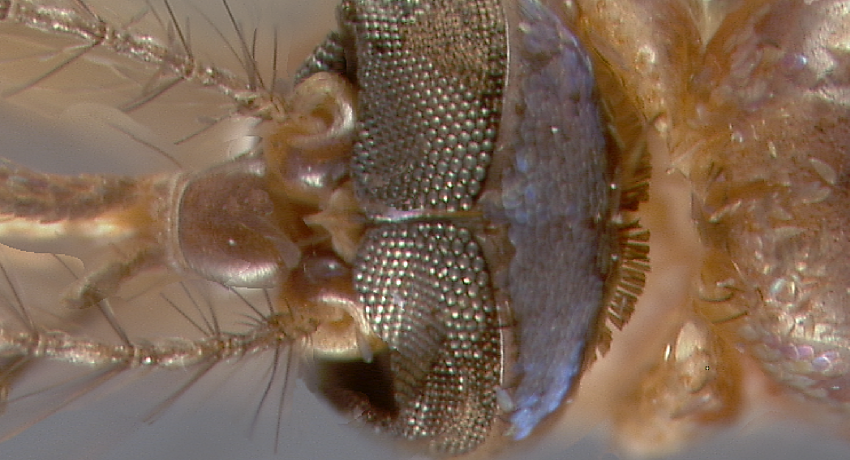NEOTROPICAL REGION
Generic abbreviation: Jb.
Type species: Culex longipes Fabricius
Etymology: John Nicholas Belkin
The Sabethine genus Johnbelkinia comprises only three species: Johnbelkinia leucopus (Dyar & Knab), Jb. longipes (Fabricius,) and Jb. ulopus (Dyar & Knab). The proboscis of Johnbelkinia species is distinctly longer than their fore femur, and adults have iridescent silver or blue scales on their vertex and occiput. The member species are closely associated with Neotropical forests.
DIAGNOSTIC CHARACTERS (Click photos to view; mouse over and click large photo to zoom in.)
ADULT (illustrated): Head: Vertex (V) and occipital scales with bright silver or blue reflections; proboscis long and slender, 1.2–1.4 x longer than Fe-I. Thorax: Scutum with broad, flat scales, dull to moderately iridescent; mesokatepisternal setae usually below lower margin of mesepimeron; dorsal margin of C-III about level with base of mesepimeron; 1–2 posterior postpronotal setae present. Legs: Ta-II,III1–5 partially pale-scaled.
LARVA (not illustrated): Head: Maxilla (Mx) modified for grasping. Abdomen: Seta 6-I–III long, multi-branched. Terminal segments: Comb with comb scales in large patch; siphon with multi-branched accessory setae (1a-S) present mid-ventrally; siphon without pecten.
TAXONOMIC KEYS
None
![]()
WRBU – Genera – Global – Larva
![]()
WRBU – Genera – Neotropical – Adult
![]()
WRBU – Genera – Neotropical – Larva
Exemplar DNA sequences
Jb. longipes COI: MF172322–27
Jb. ulopus COI: MF172328-29
All Johnbelkinia DNA sequences
BIONOMICS
Immatures
Johnbelkinia immatures are typically found in oviposit in the leaf axils and flower bracts of Alocasia, Colocasia, Heliconius and Xanthosoma plants and have occasionally been recovered from tree holes, and in water collections in fallen palm spathes and fruit husks. In Colombia, Jn. ulopus immatures were found in bamboo stumps and in the leaf axils of Xanthosoma aroids in forest environs as high as 1751m a.s.l. Larvae are predacious, and have been reported feeding on Wyeomyia larvae.
Adults
Adult Johnbelkinia have been captured transporting the eggs of Dermatobia hominis, the human bot fly. In Venezuela, Jn. ulopus is active during the day, and feeds on a variety of mammals including man. In Colombia, Jn. ulopus was collected at night in CDC light traps set in bamboo groves at 848m a.s.l.
*Associated pathogens: This list reports bacteria, viruses, and parasites recovered from, or experimentally passed through this species, and does not imply field vector status.
IMPORTANT REFERENCES (full citations below)
Zavortink 1979: 18 (as genus)
Harbach & Peyton 1993 (L mouthparts; phylogeny)
VALID SUBGENERA
None
CURRENT GENERIC SYNONYMS
None
CITED REFERENCES
Zavortink, T.J. (1979b). The new sabethine genus Johnbelkinia and A preliminary reclassification of the composite genus Trichoprosopon. Contributions of the American Entomological Institute, 17(1), 1–61.
Harbach, R.E., & Peyton, E.L. (1993). Morphology and evolution of the larval maxilla and its importance in the classification of the Sabethini (Diptera: Culicidae). Mosquito Systematics, 25(1), 1–16.
CITE THIS PAGE
Walter Reed Biosystematics Unit (Year). Johnbelkinia genus page. Walter Reed Biosystematics Unit Website, http://wrbu.si.edu/vectorspecies/genera/johnbelkinia, accessed on [date (e.g. 03 February 2020) when you last viewed the site].






